This post is David Matson’s fault. He emailed a film clip that sent me down a rabbit hole in pursuit of trivia.
Weed Alert: I chose the term “rabbit hole” for a reason (you will see). It is comparable to when I get “down in the weeds,” the term Managing Editor Rita uses when she feels a post is fine for baseball nerds, but maybe not for casual fans. So, this is your warning that you may want to proceed directly to Lonnie’s Jukebox for the music.
But for the nerds and the curious who are asking…

Kansas City A’s – Mystery Film Clip: The clip is only five minutes long, but it touches on a lot of MLB history. Click here for a first look, but then plan to go back. I’ve watched it several times and keep finding new thoughts to process.
The clip is from the YouTube site of Dallas Moore, a Texan who frequents garage and estate sales as part of his auction business. He has acquired a huge collection of vintage videos that he organizes and posts on his Forgotten Now Found website (click here).
The scenes are from back-to-back doubleheaders played by the Kansas City A’s in 1963. The origin of the footage is a mystery (so far). I’m guessing it came from the man seen at the beginning and the smiling woman seen multiple times during the footage. If anyone recognizes them, please let me know.
The description below follows the timeline in the clip. Thanks to Baseball Reference and the Baseball Almanac for stats and uniform numbers.
Saturday, July 13, 1963: The Cleveland Indians played the Kansas City A’s in a doubleheader in KC’s Municipal Stadium at 22nd and Brooklyn.
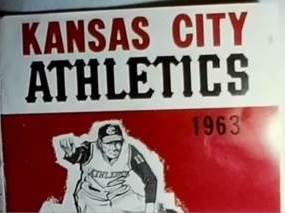
[0:05] Our mystery man in the stands.
[0:20] Umpires in their old-style caps meeting at home plate with the managers. A’s manager Ed Lopat (30) pitched 12 years in the majors, highlighted by starring on Yankee teams that won five straight World Series (1949-1953).
This was the first year the A’s wore the tradition-breaking colorful uniforms (green and gold, the colors of owner Charlie Finley’s favorite football team, Notre Dame). Click here for a video featuring Norm Siebern and Jerry Lumpe modeling the new duds.
The uniforms were “vest” style and had little room on the back for names. So, first names and nicknames were used. Kansas City Star sportswriter Joe McGuff joked that the A’s would need to trade for players with shorter names. In the photo, the players are “Doc” Edwards, Wayne “Cooz” Causey, “Norm” Siebern and Jerry “Lump” Lumpe.
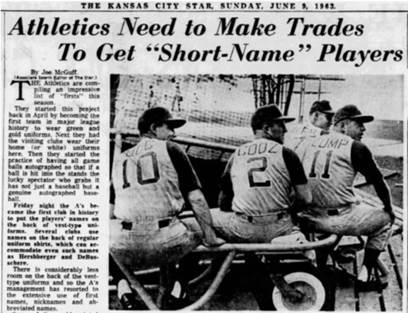
[0:27] Charlie Finley’s subterranean mechanical rabbit came up behind home plate to deliver clean baseballs to the umpire. As the rabbit ascended during games, the stadium organist played “Here Comes Peter Cottontail” (not heard in this silent clip).
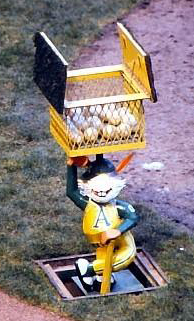
The rabbit’s name was Harvey, reportedly after the imaginary rabbit in the 1950 Jimmy Stewart movie Harvey.
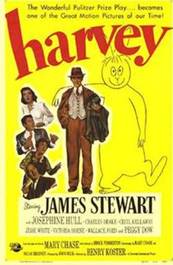
Harvey was under the supervision of famed groundskeeper George Toma who can be seen in the film clip refilling Harvey’s basket. Toma began work for the A’s in 1957, and when Finley bought the team in 1960, he recognized Toma’s value and doubled his salary. The two men developed a good working relationship. The good news for Kansas City fans is that Toma did not move to Oakland when the team left after the 1967 season. Below, Toma and Harvey.
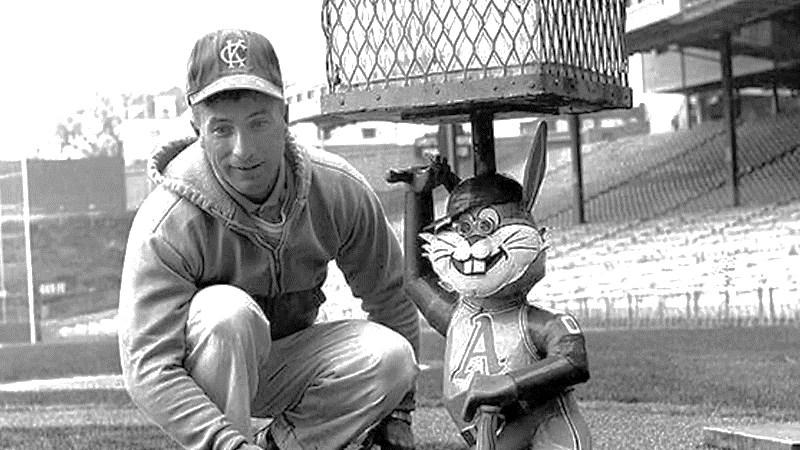
[0:41] There is a brief shot of the shepherd on “Lamb Chop Hill” behind the right field fence. He is there to tend to the sheep who ate the grass where lawnmowers feared to tread. No sheep are in the film clip, but here is what it looked like (note the A’s blankets on the sheep).
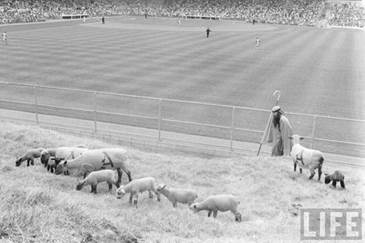
George Toma and his grounds crew oversaw the sheep and the other animals inhabiting the ballpark. A zoo in left field with monkeys, pheasants and rabbits. And Charlie O., Charlie Finley’s mule.
[0:45] Ed Charles (16) is shown crossing the plate after hitting a 2-run homer in the A’s 6-5 victory. The A’s traded Charles to the Mets in 1967, and Ed was one of the “Miracle Mets” who won the World Series in 1969. Below, his 1963 Topps card (photo taken before the regular season green and gold uniforms were inaugurated).
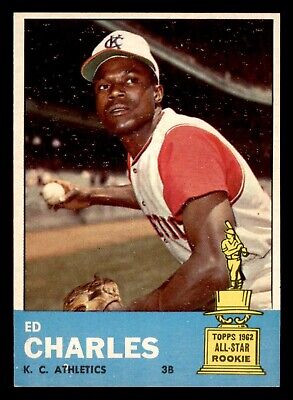
Charles played third base. Filling out the A’s infield were Norm Siebern (1B), Jerry Lumpe (2B) and Wayne Causey (SS).
[0:58] Early “Gus” Wynn pitched the second game and made history – it was his 300th career win. The newspaper in the clip is from the next day and so must have been spliced into the footage.
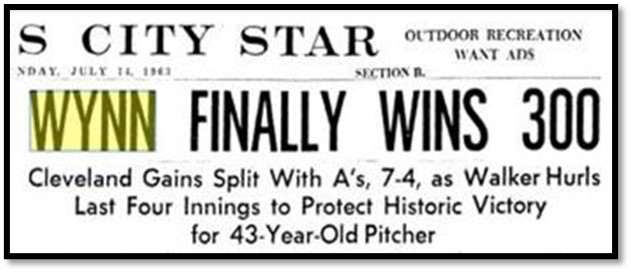
[1:18] The overweight guy warming up (36) is 43-year-old Early Wynn. He had finished the 1962 season with the Chicago White Sox, and as shown on this 1963 baseball card cut from a Post Cereal box, his career win total stood at 299.
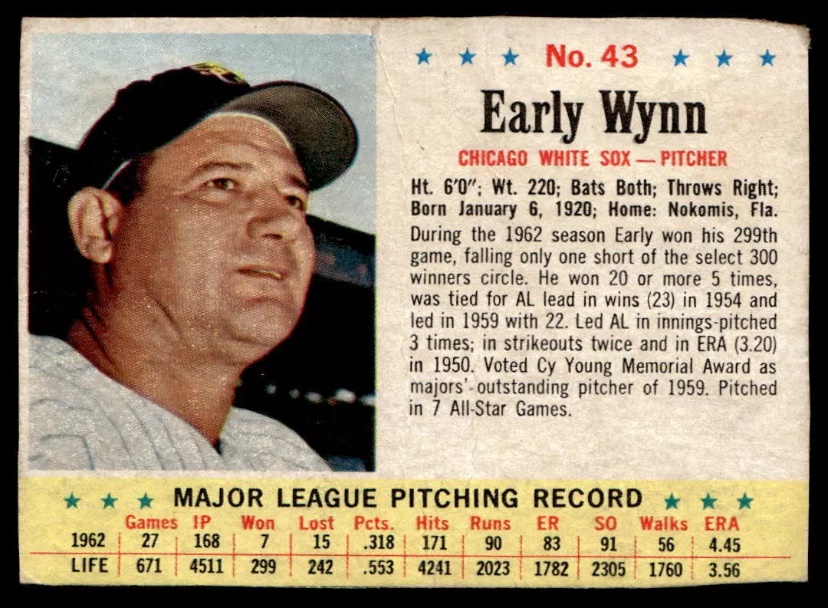
But Wynn had a problem. The White Sox elected to not sign him for 1963. He looked stuck at 299 until the Cleveland Indians came to the rescue. Wynn’s glory years had been with the Indians as a member of the “Big Four” starting rotation with Bob Feller, Bob Lemon and Mike Garcia. He now had the opportunity to “Wynn” #300.
It took four attempts, but Wynn finally succeeded on this day in Kansas City (below, Wynn in the visitors’ clubhouse after the game). It was his only win for the season, after which he retired with exactly 300.
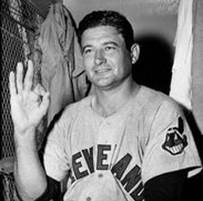
I did not see Wynn pitch this 300th victory, but Hot Stove subscriber Clay Coburn was there (then nine years old). I saw Wynn pitch in Kansas City in 1952. I was 10 years old. The hometown team was the Kansas City Blues, a minor league affiliate of the Yankees. My favorite MLB player was Phil Rizzuto, the Yankee shortstop who was the AL MVP in 1951. I was crazy about baseball and begged my parents to let me go to a major league exhibition game to be played in Kansas City before the regular season opened.
My parents said yes, and my uncle Tony Novak took me to the game. The Cleveland Indians (now Guardians) played the New York Giants. This was the Giants team that had gone to the World Series the previous year after Bobby Thomson’s walk-off “shot heard ‘round the world” beat the Dodgers. I saw Thomson get four hits in the KC game – I’m helped in my memory by the box score from the archives of the KC Star:
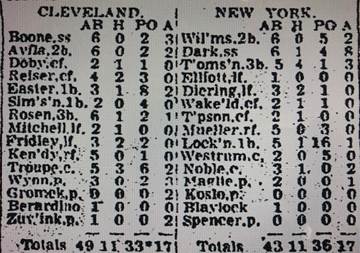
The starting pitchers were two well-known veterans, Early Wynn and Sal Maglie. In the Indians lineup was Larry Doby, the player who broke the color line in the American League (1947). The Giants’ Hank Thompson hit a two-run homer. Hank had played for the Kansas City Monarchs and broken the color line on two MLB teams – the St. Louis Browns (1947) and New York Giants (1949). The Giants won 4-3 in 12 innings.
Alas, Willie Mays was not in the lineup for the Giants. He was working on his entry into the army where he would spend most of his 1952 season.
Two years later, these two teams faced off in the 1954 World Series (the one with “the catch” by Willie Mays). The Giants won.
[1:37] Mystery woman.
[1:40] The A’s “Tony” uniform was worn by Tony La Russa who would become a Hall of Fame manager.
[Not in the footage] The shortstop for Cleveland in the second game was Dick Howser who started the season with Kansas City and was traded to the Indians in May. Howser returned to KC to manage the Royals from 1981 to 1986, winning a World Series in 1985.
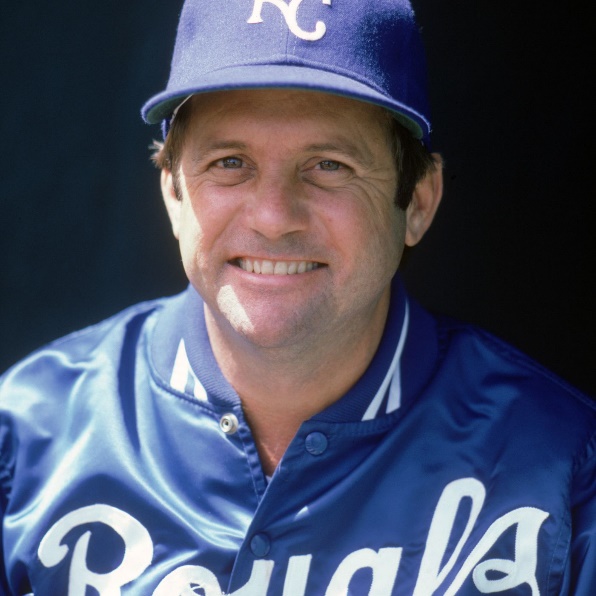
Sunday, July 14, 1963: The next day, the A’s hosted the Yankees for a doubleheader.
[2:12] The mystery couple exits the Muehlebach Hotel. The mystery woman will also appear at [4:20] and [4:55].
[2:20] Phil Rizzuto exits the hotel. Phil retired as a player in 1956 and became a long-time Yankee broadcaster (1957-1996). Phil’s signature catchphrase “Holy Cow” was the title of a Seinfeld episode where George Steinbrenner gave a key ring to Yankee employees, including George Costanza. The key ring displays Rizzuto’s head that, when squeezed, calls out “Holy Cow.” George shows his key ring to Jerry who squeezes it (2-second clip here).
[2:25] Crowd entering Municipal Stadium.
[2:40] Yankee batting practices featuring Mickey Mantle (#7) and Yogi Berra (#8). Although Mickey was taking batting practice, he was rehabbing from an injury and did not play. His #7 was memorialized in a Seinfeld episode (George wants to name his first-born “Seven” in honor of Mickey; short clip here).
[3:12] Harvey the rabbit makes another appearance, this time showing his flashing eyes.
[3:27] Scoreboard showing the 11-6 Yankee victory in the first game. Hector Lopez hit a homer for the Yankees. Hector’s MLB career started with the A’s in 1955 (their first year in KC). He was traded to the Yankees in 1959 and played for them until retirement in 1966.
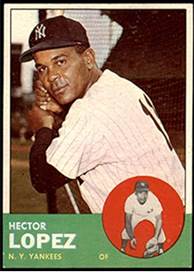
[3:30] For the second game, Yogi Berra (8) was the coach at first base. He played in the first game (3 hits), and his heir-apparent Elston Howard caught the second game. This was Yogi’s last season as a player.
[3:41] Elston Howard (32) hit a 2-run homer for the Yankees. Joe Pepitone (25) scored in front of him, and next batter Johnny Blanchard (38) greeted him at the plate. Howard’s professional career began with the Kansas City Monarchs where he played for three years (1948-1950), rooming with Ernie Banks in 1950. Blanchard is the answer to the trivia question, “Who was the catcher who called the pitch that Bill Mazeroski hit off Ralph Terry to win the 1960 World series?”
[3:56] – [4:07] Orlando Pena (19) pitching for the A’s. Tony Kubek (10) taking cuts at the plate.
[4:23] – Home run by Tom Tresh (15), his second of the game.
[4:56] Hamm’s beer scoreboard. Yankees won 5-0 to sweep the doubleheader. The script at the bottom of the Hamm’s ad reflects that the A’s were broadcast on WDAF TV and radio.
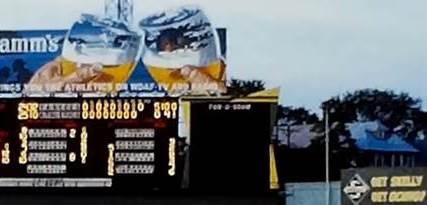
[Not in the footage] Remember the Hamm’s beer ad featuring a dancing bear (thump, thump, thump, thump) from the land of sky-blue waters? Click here. “Hamm’s, the beer refreshing.”
Further Down the Rabbit Hole: There is a second video (2 minutes) on the Forgotten Now Found site that features our mystery couple at a game on June 12, 1965 (click here and note the soundtrack with “This Old Man”).
The footage begins with the mystery couple and then moves to the team mascot, Charlie O the mule. Most of the remaining footage shows fans putting up umbrellas and the grounds crew putting down and taking up the tarp.
The scoreboard shows the pitchers as Fred Talbot (A’s) and Luis Tiant (Indians). Tiant was a very good pitcher known for his unique windups, but they did not help that day – the A’s won 7-0.
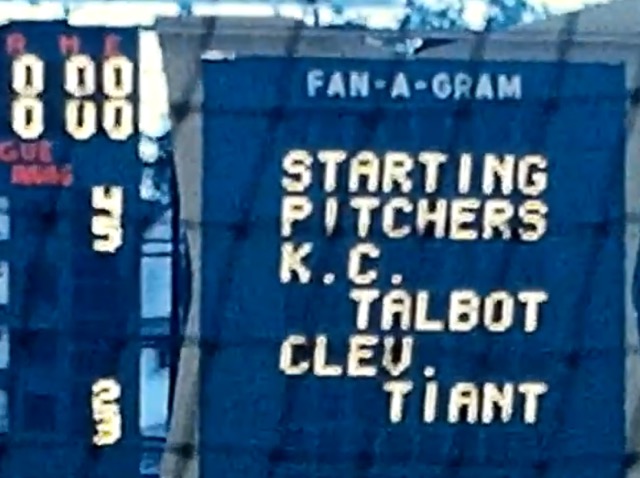
When I see the name Tiant, my first thought is the oft-quoted description of his windup by Roger Angell in the New Yorker:
His repertoire begins with an exaggerated mid-windup pivot, during which he turns his back on the batter and seems to examine the infield directly behind the mound for signs of crabgrass. With men on bases, his stretch consists of a succession of minute downward waggles and pauses of the glove, and a menacing sidewise, slit-eyed, Valentino-like gaze over his shoulder at the baserunner. The full flower of his art, however, comes during the actual delivery, which is executed with a perfect variety show of accompanying gestures and impersonations.
Angell went on to describe different classifications for Tiant’s deliveries, including “Call the Osteopath” and “The Runaway Taxi.”
I have a third video to share, but that’s enough for today.
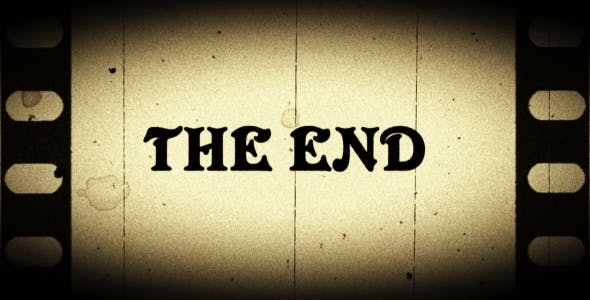
Lonnie’s Jukebox – Ozark Music Festival: Fifty years ago this month, the Ozark Music Festival was held in Sedalia. Missouri officials had rented out the state fairgrounds for what they thought would be a bluegrass festival. There were some bands that classified as blue grass, but it became more of a rockfest as bands were added. The festival ad in Rolling Stone:
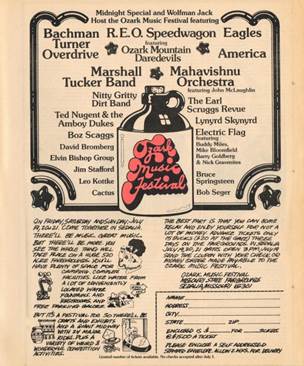
There has been a lot of media coverage this past week for the 50th anniversary, much of it related to how the crowds overwhelmed the festival organizers, law enforcement, the state of Missouri and the town of Sedalia. Estimates of the crowd run from 100,000 to 350,000.
Video, photos and interviews have been assembled by filmmaker Jefferson Lujin for a new documentary titled The Story of the Ozark Music Festival: 3 Days of Sodom & Gomorrah in Sedalia, Missouri (trailer here; Walter Cronkite opens and closes). See clips from the film in this Kansas City Star interview (click here).
In a “People’s History” podcast, KCUR refers to the festival as “Missouri’s Woodstock,” and why not – huge crowd, rock ‘n’ roll, sun/heat, drugs, nudity, etc. (click here).
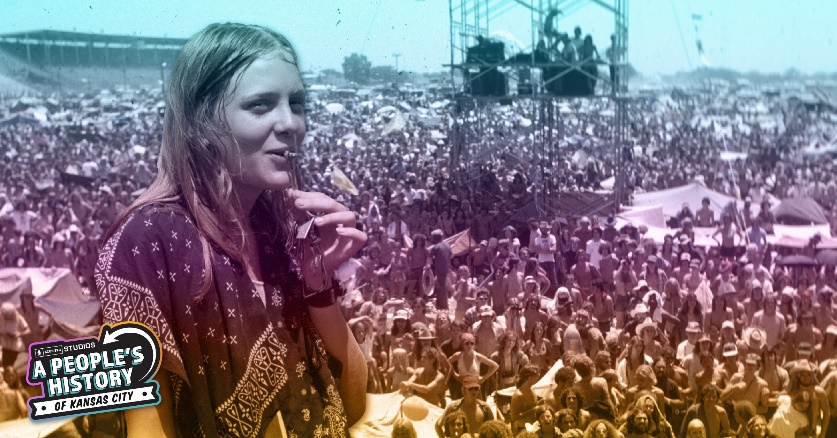
Although some of the advertised bands did not make it (Boz Skaggs, Bruce Springsteen, Jefferson Starship and the Ozark Mountain Daredevils), there were plenty of headliners and other bands (a total of 32 acts) to fill out the three days.
The festival was given good national publicity by Wolfman Jack on his popular radio show, “Midnight Special.” The Wolfman, who had appeared in American Graffiti in 1973, was on hand in Sedalia as the host.
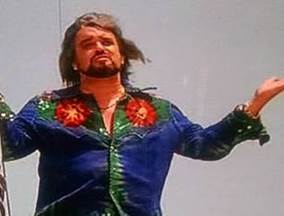
Now, for a taste of what the concertgoers likely heard from the headliners. Unfortunately, quality online concert footage is lacking, so the links below are not videos from the festival.
“Takin’ Care of Business” by Bachman-Turner Overdrive.
“You Ain’t Seen Nothing Yet” by Bachman-Turner Overdrive.
“Dream On” by Aerosmith.
“Take it Easy” by the Eagles. Joe Walsh was at the concert with his band Barnstorm. The next year, he joined the Eagles.
“Already Gone” by the Eagles. When introducing this song, a band member quipped that it was in honor of Richard Nixon who was in the middle of impeachment hearings. Nixon resigned three weeks later.
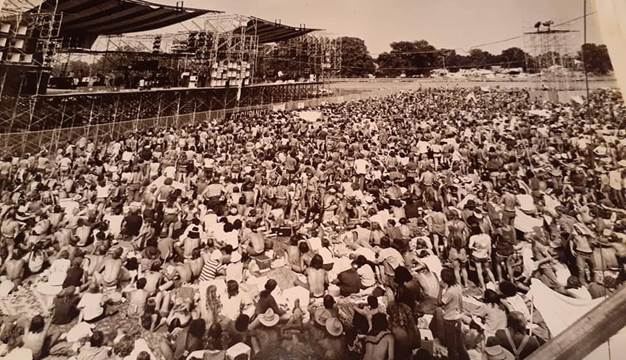
“Sweet Home Alabama” by Lynyrd Skynyrd.
“Ramblin’ Gamblin’ Man” by Bob Seger.
“Ventura Highway” by America.
“A Horse with No Name” by America, the band that closed the festival on Sunday night.
Royals Notes: Fun season. Wins are up (56 as of last night, matching the number of wins for ALL of last season). Attendance is up (15%). Yes, those are connected.
On July 28, the Royals will host the Cubs in the annual Salute to the Negro Leagues game. The Royals will wear 1924 Monarchs hats with a 100th anniversary World Series patch. The Cubs hats will feature a Buck O’Neil 1962 autograph patch (Buck was a scout and coach for the Cubs). The first 10,000 fans will receive a Monarchs hat. More info here. And if you want to tailgate with NLBM president Bob Kendrick, click here for his invitation.
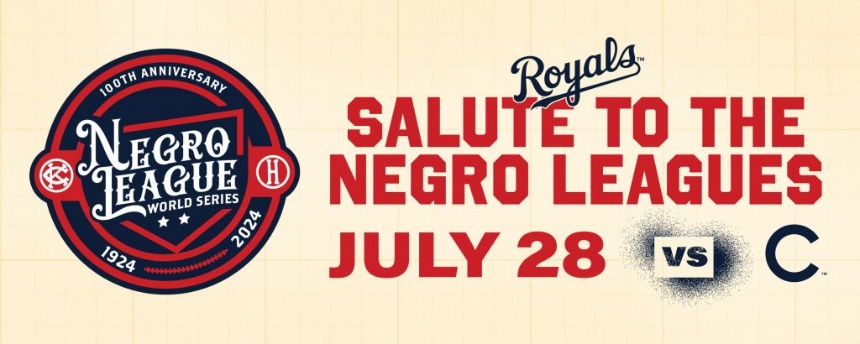
In the previous Hot Stove, I reported on our trip to Texas to see games in stadiums for the Rangers and Astros. The retractable roofs were closed for both games. I understand that certain climates require such stadiums, but I missed the open sky. That Hot Stove went out on July 3, and that very night, the Royals sent out tweets from the game that confirmed my appreciation for roofless stadiums.

